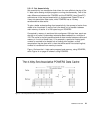
42 RS/6000 43P 7043 Models 150 and 260 Handbook
Figure 14. The 128-Way Set Associative POWER3 L1 Data Cache
Each cell represents a cache line; each column is called a congruence class.
Figure 13 on page 41 contains 128 congruence classes. There are four rows
in the cache area of the figure. Each of these rows contains 128 cache lines
of 128 bytes each (128 x 128 = 16 KB).
Any particular line from memory may only be loaded into a cache line in the
same congruence class: for POWER2, into one of only four locations; for
POWER3, into one of 128 locations.
Generally, when a new line from memory is loaded into the cache, existing
data must be displaced. If the previous contents of the line have been
modified, the line must be stored back into memory. The algorithm used by
the hardware for selecting which cache line to use is an approximation of
Least Recently Used on POWER2, and is Round-Robin on POWER3.
The set associative structure of the cache can lead to a reduction in its
effective size. Suppose successive data elements are being processed that
are regularly spaced in memory (that is with a constant stride). With the
POWER2 cache, the worst case is when the stride is exactly 16 KB (128 lines
X 128 bytes each) or a multiple of 16 KB. In this case, all elements will lie in
the same congruence class and the effective cache size will be only four


















